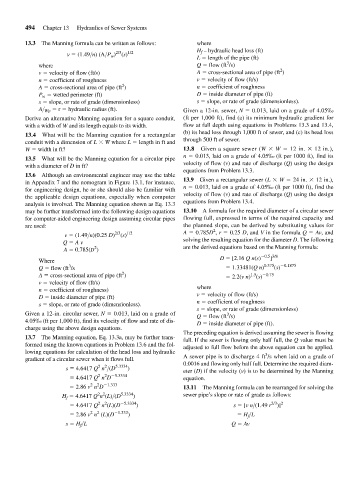Page 536 - Fair, Geyer, and Okun's Water and wastewater engineering : water supply and wastewater removal
P. 536
JWCL344_ch13_457-499.qxd 8/7/10 8:49 PM Page 494
494 Chapter 13 Hydraulics of Sewer Systems
13.3 The Manning formula can be written as follows: where
H f hydraulic head loss (ft)
2/3
1/2
v (1.49>n) (A>P w ) (s)
L length of the pipe (ft)
3
where Q flow (ft /s)
2
v velocity of flow (ft/s) A cross-sectional area of pipe (ft )
n coefficient of roughness v velocity of flow (ft/s)
2
A cross-sectional area of pipe (ft ) n coefficient of roughness
P w wetted perimeter (ft) D inside diameter of pipe (ft)
s slope, or rate of grade (dimensionless) s slope, or rate of grade (dimensionless).
A> Wp r hydraulic radius (ft). Given a 12-in. sewer, N 0.013, laid on a grade of 4.05‰
Derive an alternative Manning equation for a square conduit, (ft per 1,000 ft), find (a) its minimum hydraulic gradient for
with a width of W and its length equals to its width. flow at full depth using equations in Problems 13.3 and 13.4,
(b) its head loss through 1,000 ft of sewer, and (c) its head loss
13.4 What will be the Manning equation for a rectangular
conduit with a dimension of L W where L length in ft and through 500 ft of sewer.
W width in ft? 13.8 Given a square sewer (W W 12 in. 12 in.),
n 0.013, laid on a grade of 4.05‰ (ft per 1000 ft), find its
13.5 What will be the Manning equation for a circular pipe
with a diameter of D in ft? velocity of flow (v) and rate of discharge (Q) using the design
equations from Problem 13.3.
13.6 Although an environmental engineer may use the table
in Appendix 7 and the nomogram in Figure 13.1, for instance, 13.9 Given a rectangular sewer (L W 24 in. 12 in.),
for engineering design, he or she should also be familiar with n 0.013, laid on a grade of 4.05‰ (ft per 1000 ft), find the
the applicable design equations, especially when computer velocity of flow (v) and rate of discharge (Q) using the design
analysis is involved. The Manning equation shown as Eq. 13.3 equations from Problem 13.4.
may be further transformed into the following design equations 13.10 A formula for the required diameter of a circular sewer
for computer-aided engineering design assuming circular pipes flowing full, expressed in terms of the required capacity and
are used: the planned slope, can be derived by substituting values for
2
2/3
v (1.49>n)(0.25 D) (s) 1/2 A 0.785D , r 0.25 D, and V in the formula Q Av, and
Q A v solving the resulting equation for the diameter D. The following
2
A 0.785(D ) are the derived equations based on the Manning formula:
]
D [2.16 Qn(s) 0.5 3/8
Where
3
Q flow (ft /s 1.33481(Q n) 0.375 (s) 0.1875
2
1.5
A cross-sectional area of pipe (ft ) 2.2(v n) (s) 0.75
v velocity of flow (ft/s)
n coefficient of roughness) where
D inside diameter of pipe (ft) v velocity of flow (ft/s)
s slope, or rate of grade (dimensionless). n coefficient of roughness
s slope, or rate of grade (dimensionless)
Given a 12-in. circular sewer, N 0.013, laid on a grade of Q flow (ft /s)
3
4.05‰ (ft per 1,000 ft), find its velocity of flow and rate of dis- D inside diameter of pipe (ft).
charge using the above design equations.
The preceding equation is derived assuming the sewer is flowing
13.7 The Manning equation, Eq. 13.3a, may be further trans- full. If the sewer is flowing only half full, the Q value must be
formed using the known equations in Problem 13.6 and the fol- adjusted to full flow before the above equation can be applied.
lowing equations for calculation of the head loss and hydraulic 3
gradient of a circular sewer when it flows full. A sewer pipe is to discharge 4 ft /s when laid on a grade of
0.0016 and flowing only half full. Determine the required diam-
2
2
5.3334
s 4.6417 Q n >(D )
eter (D) if the velocity (v) is to be determined by the Manning
2
2 5.3334
4.6417 Q n D equation.
2
2 1.333
2.86 v n D 13.11 The Manning formula can be rearranged for solving the
2 2
H f 4.6417 Q n (L)>(D 5.3334 ) sewer pipe’s slope or rate of grade as follows:
2/3 2
2
2
4.6417 Q n (L)(D 5.3334 ) s [v n>(1.49 r )]
2
2
2.86 v n (L)(D 1.333 ) H f >L
s H f >L Q Av

